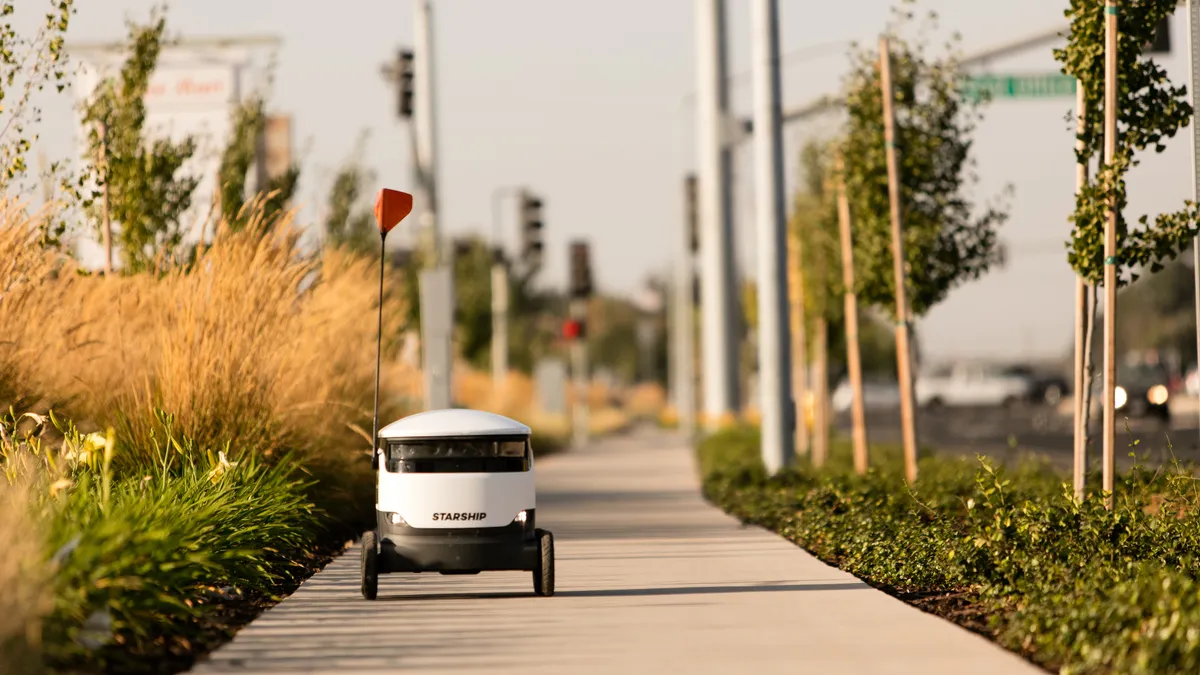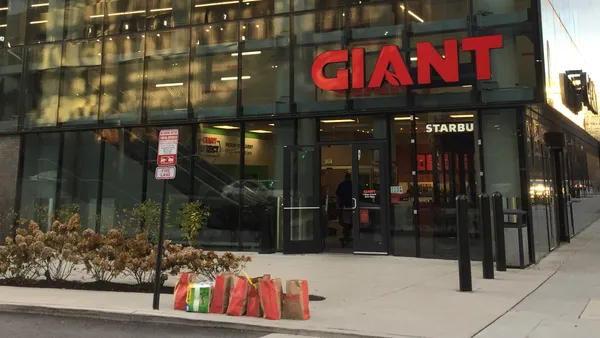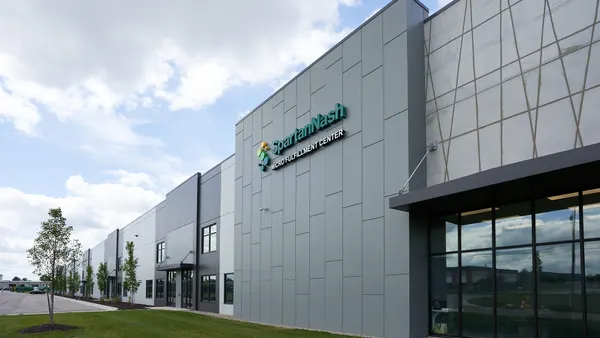For most consumers, autonomous grocery delivery has been more of a neat-to-have service than a need-to-have one. During the pandemic, however, when the desire for not just delivery but contactless delivery has grown rapidly, the idea of having a robot pull up curbside with milk, eggs, cereal and other goods suddenly sounds a whole lot more appealing.
That means that now, consumer demand, as well as the need for improved last-mile economics during an unprecedented digital sales boom, are fueling autonomous delivery. Tech companies like Nuro and Starship Technologies say their bots are working overtime delivering groceries and other goods. They’re accelerating the timelines for their pilot programs, working with local and national authorities to cut through red tape, and laboring to innovate quickly and keep up with the shifting market.
"We've seen grocery e-commerce in some cases double, and with our Kroger partnership that has more than doubled," said David Estrada, chief legal and policy officer at Nuro, which currently operates a pilot with Kroger across six ZIP codes in Houston.
Amazon and Walmart both recently launched drone delivery programs, shining a brighter spotlight on a futuristic service that promises to speed up delivery times and eventually bring down costs. But robo delivery comes with restrictions, including where vehicles can operate and how fast they can run.
“While sandwich delivery by robots has become a reality in several carefully chosen ZIP codes, each with low traffic and a generally well-kept infrastructure, there are plenty of towns and cities where delivery robots would face significant challenges just getting around safely,” read a recent assessment from the trade publication AutoWeek.
Autonomous delivery companies say the geographies where their robots can run is gradually expanding. Still, it’ll be a while before the technology will be scalable and cost-effective, company officials said.
"For us, one of the things we’ve really been pushing is how do we get the unit economics and the price point of these vehicles low enough," said Matthew Johnson-Roberson, co-founder of Refraction AI, whose vehicles are currently delivering groceries and restaurant meals in Michigan.
Here’s a look at four autonomous delivery companies, the progress they’ve made during the pandemic and the challenges that still lie ahead.
Nuro
Headquarters: Mountain View, California
Retail partners: Kroger, Walmart, CVS
Vehicle top speed: 25 mph
Nuro scored a regulatory win back in February when the U.S. Department of Transportation granted approval for the company’s fully autonomous R2 vehicles — the first such approval for a driverless delivery vehicle. Now, says Estrada, the company is working with regulators to allow it to increase the maximum speed for its vehicles, currently 25 miles per hour, which would allow it to travel on a greater number of roads.
In its February ruling and its subsequent evaluations, the Transportation Department has recognized that delivery vehicles like the R2 don’t have to meet traditional vehicle regulations, Estrada said. R2 doesn’t have side mirrors, rearview mirrors or airbags.
Nuro had planned on rolling out the R2 back in the spring, but pulled back as grocers fought to keep their shelves and warehouses stocked. Estrada said the company plans to roll out R2 in Houston this year with one of its partner companies — currently Kroger, Walmart, CVS and Domino’s. He wouldn’t say which company, though he did confirm that Kroger, as previously announced, does plan to begin making deliveries with the R2 in the city at some point.
Kroger partnered with Nuro in 2018 and began offering deliveries via the tech firm’s manned R1 vehicles in Arizona. That pilot shifted to Houston last year, where Kroger customers in six ZIP codes are currently receiving grocery deliveries from manned Toyota Prius vehicles utilizing R2 technology.
“This is a new experience for people that takes some getting used to."

David Estrada
Chief legal and policy officer, Nuro
Estrada said the significant increase in deliveries this year has allowed Nuro to refine its technology. He noted the “stickiness” of service has improved as Kroger customers get used to ordering, receiving a text when their groceries arrive and then walking to the curb to retrieve everything.
“This is a new experience for people that takes some getting used to. Once they get used to it, then it becomes habitual,” Estrada said.
Nuro is currently working on a next-generation driverless vehicle, known as R3 for the time being, that Estrada said will eventually become the company’s fully scalable, mainstream delivery vehicle. Nuro, which received a nearly $1 billion investment last year from Softbank, is also pitching its robotic vehicles as a service solution for food deserts, noting that the vehicles could serve markets that are unsustainable for a full-service store and at a lower operational cost.
"We're having these conversations with our partners and we’re going to be increasingly focusing on this," Estrada said. "It's something that they have wanted to solve and haven’t found a good solution for, and now we offer a better solution."
Starship Technologies
Headquarters: San Francisco
U.S. retail partners: Save Mart
Vehicle top speed: 4 mph
Prior to the pandemic, the main place to find Starship’s sidewalk-roving robots in the U.S. was on college campuses delivering meals to hungry students. After schools shut down, Starship shifted gears to its grocery delivery deployments, which were mainly taking place overseas.
In the U.K. this spring, the company’s service just outside London swelled to the point where it was adding several grocery stores per week, said Ryan Tuohy, Starship’s senior vice president of business development. In just a few months’ time, it added 50,000 households, picked up partnerships with Tesco and Budgens in addition to its initial partner, Coop, and filled hundreds of thousands of orders that improved its delivery intelligence.
Last month, Starship inked its first deal with a U.S. grocer, Save Mart, which will offer delivery from its flagship store in Modesto, California.
Traveling just 4 mph, Starship’s bots might sound too slow to accommodate the fast pace of online grocery fulfillment. But Tuohy said the bots can handle most two- and even one-hour deliveries, since shoppers typically live within a few miles of their preferred grocer. Although each vehicle can only carry two to three bags of groceries — a seemingly small amount at a time when stock-up shopping has become the norm — he noted a significant subset of customers order two or three times a week through the service.
Starship offers service through its own app and marketplace, which depending on the region includes grocers as well as restaurants. Tuohy said this is how the company prefers to work with grocers, but left open the possibility of alternative arrangements.
“There's an additive effect to having a network of different choices within the app,” he said. “Time will tell how our partnerships and relationships evolve, but I believe wholeheartedly in the value of a marketplace."
Starship currently has 1,000 robots in service globally, and Tuohy said the company is working quickly to increase that number. It’s also continuously honing its vehicles' artificial intelligence. The bots do more than 90% of movement autonomously, but a remote human controller must navigate tricky spots like busy intersections and construction zones.
"We've crossed streets over 5 million times, and most of the time it's autonomous, but there's certain level of traffic conditions that trigger the robot to ask permission for a particular crossing," he said.
Refraction AI
Headquarters: Ann Arbor, Michigan
U.S. retail partners: The Produce Station
Vehicle top speed: 15 mph
The pandemic served up two major benefits for Michigan-based Refraction AI this spring. The first was a significant uptick in order volume from the handful of restaurants and independent grocery stores from which the company’s bicycle-sized bots deliver. The second was a lot of empty roads.
“There was this huge playground of roads where we could push the envelope a lot more in testing the vehicles,” said Johnson-Roberson. “We got a lot of training data.”
Johnson-Roberson launched Refraction AI last year in Ann Arbor, where he worked at the University of Michigan and where, snowy winters notwithstanding, the city’s straightforward system of roads and large university population make it an ideal place to test autonomous delivery. The firm started by delivering from a handful of restaurants before adding service from local grocer The Produce Station.
Refraction’s autonomous REV-1, which measures around 4 feet tall and shuttles up to six bags of groceries for a flat $7.50 fee, quickly became a workhorse for the grocer. “Order frequency went way up,” Johnson-Roberson said. Confident the increase wasn’t just a blip, Refraction quickly built more bots, growing its fleet from 10 to 25 by the end of last month.
The REV-1, which is legally classified as an e-bike, has 12 sensor cameras and can make deliveries in the snow and rain. The $7.50 fee, meanwhile, is charged to the business, which can choose to fully shoulder the cost or pass some of it along to the customer.
"For us, one of the things we've really been pushing is how do we get the unit economics and the price point of these vehicles low enough."

Matthew Johnson-Roberson
Co-founder, Refraction AI
Now, Johnson-Roberson has his eye on expansion. He’s been speaking with chain grocers in the area, and recently built a REV-1 hub on the west side of town where many grocery stores are located. Refraction’s vehicles dock at the hub and can travel up to 3.5 miles in any direction from it. The firm is also exploring regional moves to other cities in Michigan and nearby Ohio.
Johnson-Roberson said retailers at first seemed “leery” of robo delivery, but have warmed up to the technology as the pandemic has dragged on. He said many are adding dedicated fulfillment spaces to their stores that make it easier to link up with autonomous vehicles. He also said grocers are interested in handling more of the order picking themselves and reducing delivery costs.
But Johnson-Roberson acknowledged that his company, along with other autonomous vehicle firms, face a steep challenge in cost-effectively scaling up. He estimated most robo delivery bots cost between $50,000 and $250,000 to manufacture, and said he wants to get the full cost for each of his vehicles down to around $5,000.
Deuce Drone
Headquarters: Mobile, Alabama
U.S. retail partners: Rouses Markets
Vehicle top speed: 30+ mph
Like Refraction AI, Deuce Drone has benefited from an increase in empty spaces during the pandemic. After the University of South Alabama closed down in the spring, the Mobile-based company began using the school’s grounds to further test its 3-foot-wide quad copters, which can carry up to 12 pounds worth of groceries and other goods.
“We no longer had to worry about finding an empty field and no people around,” said Rhett Ross, CEO of Deuce Drone.
That data will help Deuce Drone when it starts making deliveries from Rouses grocery stores and local restaurants by the end of the year. The test is slated to include five drones shuttling between participating locations, which includes a local Buffalo Wild Wings franchise, and then to consumers’ homes.
Shoppers, who will initially be vetted by Deuce Drone to make sure they have proper landing space on-site and don’t have any pets or children that could present a safety hazard, will order through the drone operator’s app. An employee at each store will then pick the order, load it into special bags and then attach those to the drone, docked at a dedicated pod, before liftoff.
Each drone can travel up to four miles in any direction at a speed of nearly 40 mph. That means the airborne couriers can cover a lot of distance quickly, Ross said, ensuring that hot foods stay hot and cold foods stay cold. He estimated each drone could travel in six minutes the same distance a vehicle could cover in 30 minutes.
Ross said the test will help Deuce Drone hone its loading and unloading of orders. The company will also look to improve the takeoff, landing and flight capabilities as it looks to expand service to other area retailers.
Long a pie-in-the-sky idea, drone delivery has taken wing recently as technology has advanced and the Federal Aviation Administration has cleared the way from a regulatory perspective, issuing approval to companies like UPS and Wing Aviation beginning last year. Amazon and Walmart have both launched drone delivery recently that includes grocery orders.
Ross also believes consumer approval is important. In tandem with its drone delivery pilot this year, his company will hold educational events inside Rouses stores and restaurants, where shoppers will be able to see a mock-up of the drone and feel how much weight it can carry.
“That’s all to help them get exposed to the opportunity, but also to have them able to ask the questions they want to ask,” Ross said. “We want them to be ready for that, so as it rolls out there’s less surprise.”












